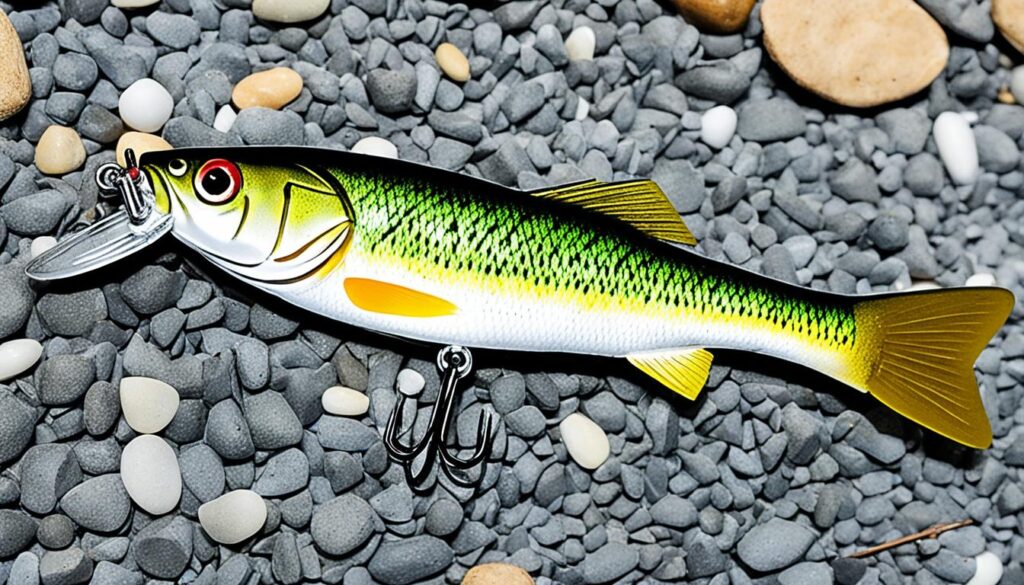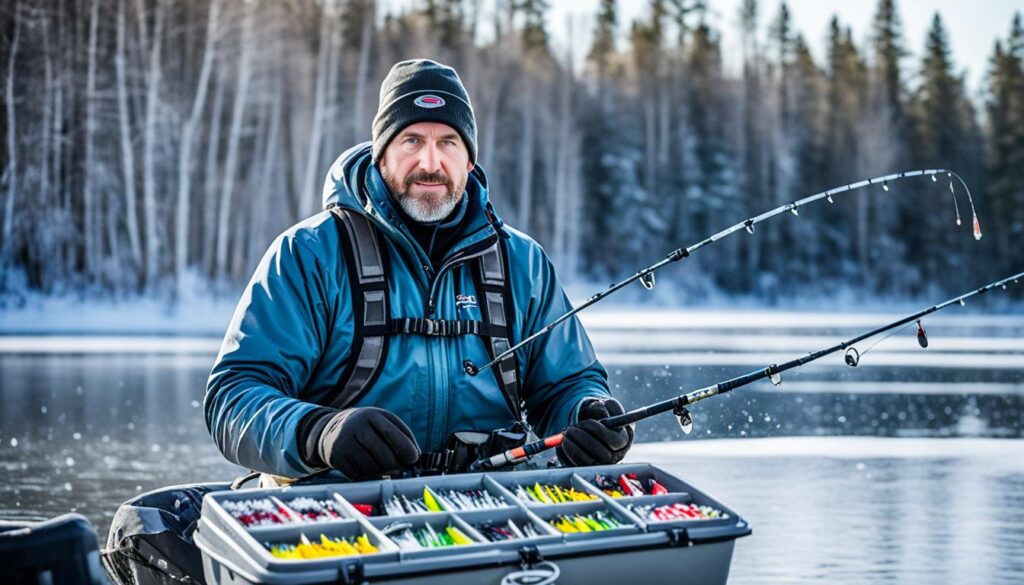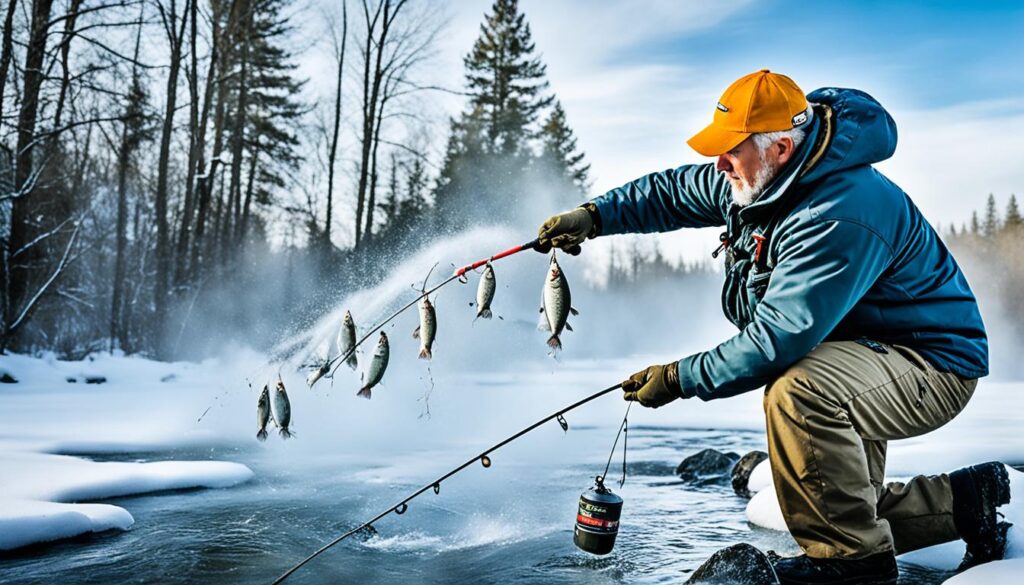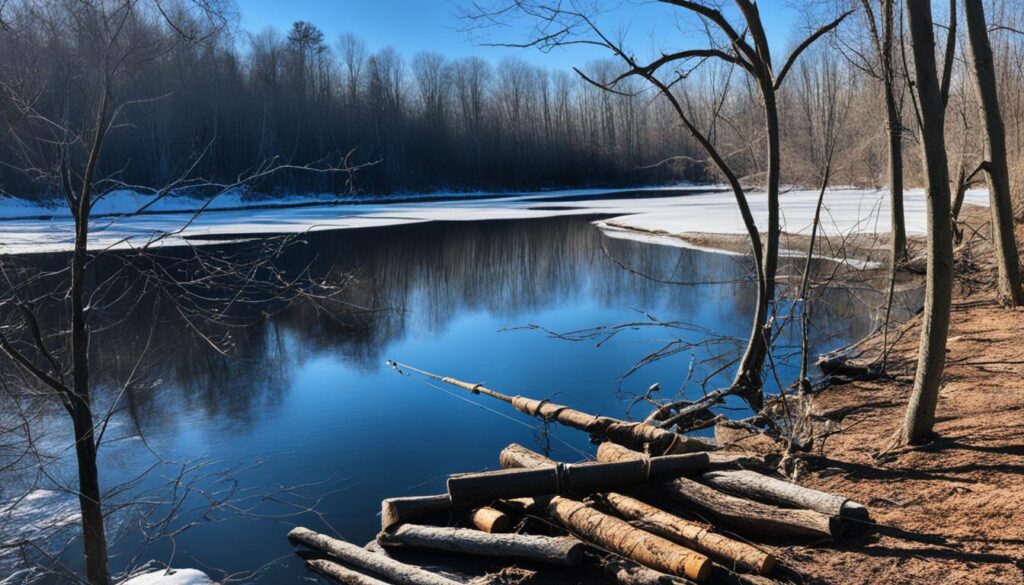Winter bass fishing poses challenges, primarily because bass tends to become lethargic in cold water. However, with the right approach, you can turn the odds in your favor even during the chilly months. One effective tactic to consider is utilizing jerkbaits around cover.
These lures possess a distinct action that closely imitates injured baitfish, which proves irresistible to bass, even when temperatures drop. Mastering jerkbaits can significantly boost your catch rate and make your winter bass fishing endeavors more rewarding.
The Basics of Jerkbait Fishing in Winter
Incorporating jerkbaits into your strategy can be a game-changer for winter bass fishing. These specialized lures are crafted to replicate the movements of injured baitfish, a tempting sight for sluggish bass in colder waters. Mastering the essentials of using these lures effectively is vital to excelling during winter expeditions jerk bait fishin’.
A vital aspect of jerkbait fishing in winter revolves around pinpointing the optimal locations. As bass seek refuge in cover and structure when the water temperature drops, scouting areas featuring submerged vegetation, rocky formations, or fallen trees is imperative. These hiding spots provide shelter for bass and heighten your chances of a successful catch.
The technique of working jerkbaits demands a delicate balance of twitches and pauses, mimicking the erratic movements of wounded prey.
This method effectively triggers the predatory instincts of bass, enticing them into striking. Experimentation with various retrieval speeds (how fast you reel in the lure) and cadences (the rhythm of your twitches and pauses) is crucial. Determining the most effective approach tailored to the prevailing conditions and the temperament of the bass.
“Jerkbaits are a versatile tool for winter bass fishing. By mimicking the movements of injured baitfish around structure, anglers can entice bites from even the most finicky bass.” – Bass Fishing Pro
.Here are some jerkbait fishing strategies to keep in mind while targeting bass in winter:
- Fish around the structure and cover where bass are likely to hide, such as submerged vegetation, rocks, and fallen trees.
- Use a combination of twitches and pauses to imitate the movements of injured prey.
- Experiment with different retrieval speeds and cadences to find what works best.
Choosing the Right Jerkbait for Winter Fishing
Selecting the appropriate jerkbait is pivotal to success during winter bass fishing excursions. In colder months, it is paramount to prioritize smaller jerkbaits ranging from three to five inches in length. This size closely mirrors the smaller baitfish prevalent during winter, increasing the likelihood of enticing a strike by matching the natural prey’s size.
When deliberating on color and finish, opt for jerk baits that resemble the indigenous prey inhabiting the water. Jerkbait Lures have patterns emulating shad, minnows, or other common baitfish species. Shades like chartreuse with a black back or metallic finishes often prove effective, as they enhance visibility and allure in diverse water conditions. Remember, visibility emerges as a crucial factor in winter fishing endeavors.
| Jerkbait Characteristics | Impact on Winter Fishing Success |
|---|---|
| Smaller Size (3-5 inches) | Increase chances of enticing strikes from winter bass. |
| Color & Finish Mimicking Prey | Enhance visibility and attract attention in various water conditions. |
| Sharp Hooks | Ensure better hooksets for landing fish. |

Adapting Techniques for Winter Jerkbait Fishing
Adjusting your techniques while fishing in the winter is essential for effectively targeting bass with jerkbaits. During this season, bass exhibits less activity and prefers a slower, more methodical presentation. To entice sluggish bass, a deliberate retrieve with frequent pauses is crucial.
Please be patient and allow the jerkbait to remain motionless for extended periods before introducing subtle twitches to elicit strikes. Additionally, enhancing hookups can be achieved by adding an extra split ring to the back hook. These adaptations significantly improve your prospects for success in winter jerkbait fishing.
Modifying the Retrieve
In the chilly grip of winter, bass activity dwindles, and it’s a tailored approach to your retrieve. Instead of employing rapid, aggressive movements, opt for a slower, more deliberate pace. This approach emulates the behavior of injured prey, appealing to the passive nature of winter bass. Embrace prolonged pauses, allowing the jerkbait to simulate an easy meal for discerning bass. Exercise patience is paramount as a slow and steady approach, particularly in winter fishing.
Incorporating Subtle Twitches
While prioritizing a slow retrieve is pivotal in winter jerk bait fishing, integrating subtle twitches into the bait can significantly heighten your chances of eliciting strikes. Following a period of motionlessness, delicately twitch the rod tip to impart subtle movements to the bait. These nuanced actions replicate the erratic motions of injured prey, enticing even the most sluggish bass. You can experiment with various twitching patterns to find the most effective approach tailored to the bass behavior in your fishing locale.
Utilizing an Additional Split Ring
During cold weather, the bass often nip and go, momentarily grasping the jerk bait before releasing it. To augment hookups in such scenarios, consider affixing an extra split ring to the rear hook of the jerkbait. This simple modification introduces a degree of slack, allowing bass to linger on the bait slightly longer, thereby increasing the likelihood of a successful hookup.
| Adjusting Techniques for Winter Jerkbait Fishing | Advantages |
|---|---|
| Slow and deliberate retrieve | – Mimics injured prey – Entices sluggish bass – Increases strike opportunities |
| Applying subtle twitches | – Mimics movements of injured prey – Triggers strikes from lethargic bass – Adds action to the bait |
| Using an extra split ring | – Helps increase hookups – Prevents bass from nipping and releasing bait – Improves hookup ratios |
Identifying Optimal Fishing Locations for Winter Bass Jerkbait Fishing
Effective winter bass fishing with jerkbaits hinges on pinpointing the right fishing spots. Concentrating your efforts on areas abundant in structure and cover significantly boosts your likelihood of encountering active-feeding bass during the colder months. Here are vital locations to prioritize:
- Fishing around Structure: Seek out areas boasting submerged vegetation, docks, rocky points, and drop-offs. These structural elements serve as a sanctuary for bass, attracting baitfish and transforming into prime hunting grounds.
- Channel Swings near Old Creek Channels: Channel swings adjacent to steep banks emerge as winter bass hotspots. The deep waters flanking the channels provide bass with a sense of security, while the bends offer strategic ambush points for feeding.
When selecting fishing locations, it’s essential to factor in water clarity. Optimal winter jerkbait fishing conditions for bass typically found in slightly stained or clear water. These conditions facilitate enhanced visibility, enabling bass to perceive and target the bait readily. Prioritize fishing in areas boasting these favorable water conditions to optimize your chances of success.
“When targeting bass in winter, fishing around structure and focusing on key locations is essential. Please look for areas with submerged vegetation, docks, rocky points, and drop-offs. Channel swings near old creek channels are particularly productive. Pay attention to water clarity and target slightly stained or clear water for optimum success.”
Essential Gear and Tackle for Winter Bass Fishing
When venturing into winter bass fishing, having the appropriate gear and tackle can significantly elevate your chances of success, especially when employing jerkbaits. Here are essential items to optimize your performance:
- Rod:
Select a lightweight and sensitive rod to facilitate accurate and delicate presentations. Opt for a medium-light or medium power rod, ideally suited for maneuvering jerkbaits with finesse during winter.
- Reel:
You can pair your chosen rod with a high-quality spinning or baitcasting reel, depending on your preference and comfort level. Both reel types are effective for jerkbait fishing, so opt for the one that aligns best with your fishing style.
- Line:
A 6-8 lb test fluorocarbon line is best used to enhance lure action and sensitivity. The Fluorocarbon line boasts reduced visibility underwater, increasing the likelihood of enticing strikes from cautious bass.
- Hooks and Split Rings:
Please ensure your jerkbait treble hooks are sharp and the split rings are not rusted. These components are integral to hooking success, mainly when bass exhibit swift strikes. Opting for sharp hooks and robust split rings enhances your ability to secure more fish during winter jerkbait fishing outings.

Adapting Jerkbait Techniques to Different Water Conditions
Tailoring your jerkbait fishing techniques to varying water conditions is paramount for achieving success, especially when targeting winter bass. How you manipulate your lure can profoundly influence your ability to entice strikes. Here are vital techniques to employ:
In Clear Water: When confronted with clear water conditions, employ shorter twitches and pauses to replicate the movements of injured prey. Bass inhabiting clear waters benefit from enhanced visibility, necessitating a subtle and lifelike presentation to stimulate their predatory instincts effectively.
In Stained Water: Intensify your cadence and adopt a more aggressive stained or murky water-twitching approach. The objective is to generate pronounced noise and vibration, captivating the attention of bass that rely heavily on their lateral lines to detect prey amidst reduced visibility.
By adapting your jerkbait techniques to suit the prevailing water conditions, you can maximize your chances of eliciting strikes from winter bass and enhance your overall fishing success.
| Water Conditions | Technique |
|---|---|
| Clear Water | Shorter twitches and pauses to imitate injured prey |
| Stained Water | Increased cadence and more aggressive twitches to create noise |

Insights from Experts for Winter Jerkbait Fishing
Seasoned anglers offer invaluable insights for optimizing your winter jerkbait fishing endeavors. Integrating these expert tips into your fishing strategy can significantly enhance your success in cold weather. Here are key insights to incorporate:
Add Split Ring
During winter jerk bait fishing, the bass tends to “nip” at the bait rather than fully committing by adding a split ring to the rear hook to bolster your hook-up ratio. This simple adjustment can substantially improve your ability to hook short strikers, transforming more bites into solid catches.
Opt for Metallic Hues
In clear or slightly stained water, jerkbaits adorned with metallic hues can prove exceptionally effective. With their transparency and metallic flash, colors like TENNESSEE SHAD closely emulate bass’s natural prey. Opting for lures featuring these vibrant finishes, you can attract heightened attention from bass during winter.
Experiment with Twitching and Pausing
You can just experiment with slightly quicker twitches and briefer pauses in clear water conditions when working your jerkbait. This action mimics the injured prey’s erratic movements, eliciting bass reaction strikes. By varying the tempo and cadence of your retrieval, you can determine the most enticing presentation for bass in different water conditions.
Focus on Channel Swings
Channel swings flanking steep banks near old creek channels are productive locales for winter jerkbait fishing. Bass often congregate in these areas, utilizing them as strategic ambush points to target passing baitfish. Directing your efforts towards these specific zones can elevate your chances of landing more bass during cold weather excursions.
Remember to maintain keen observation and adaptability while on the water. Remain attuned to bass behavior, and be prepared to adjust your techniques accordingly. Though winter bass fishing presents challenges, armed with insights from seasoned anglers, you’ll be well-equipped to maximize your fishing endeavors during the colder months.
Conclusion
Winter bass fishing presents challenges, but employing jerkbaits around cover can substantially elevate your success rate. Applying the tips and techniques in this article, you can refine your skills and excel at targeting bass during the colder months.
Critical to your success is the selection of the right jerkbait. Opt for smaller sizes like the [Rapala X-Rap], [Megabass Vision 110], or [Lucky Craft Pointer], which mirror the prevalent smaller baitfish in winter waters. Pay close attention to the color and finish of your jerkbait, choosing options that closely mimic the natural prey in the water. Experimentation with various retrieval speeds and cadences is essential to finding the optimal combination tailored to prevailing conditions and bass temperament.
Moreover, it’s essential to adapt your techniques to specific water conditions. In more transparent water, employ shorter twitches and pauses to replicate the movements of injured prey. Conversely, intensify the cadence in stained water and utilize more aggressive twitches to generate noise and attract attention. Targeting key locations such as submerged vegetation, where bass seek shelter and food; docks, which provide shade and cover; rocky points, which act as ambush points; and drop-offs, where bass can find deeper, warmer water, can significantly enhance your prospects for success.
Embrace patience and remain open to experimentation and adaptation in your approach. With the right jerkbait, adept technique adjustments, and strategic location targeting, you can elevate your catch rate and relish a fulfilling winter bass fishing venture. Embrace the challenge, brave the cold, and reel in those elusive winter bass!
FAQ
What is jerkbait fishing?
Jerkbait fishing is a technique where anglers use lures that have a unique action to mimic injured baitfish, making them irresistible to bass.
How do I fish with jerkbaits in winter?
In winter, focus on fishing around structure and cover where bass are likely to hide. Work the jerkbait with a combination of twitches and pauses to imitate the erratic movements of injured prey.
What size jerkbaits should I use in winter?
Opt for smaller jerkbaits between three to five inches in length to match the smaller baitfish prevalent during this season.
What color jerkbaits should I use in winter?
Choose jerkbaits that mimic the natural prey in the water, such as chartreuse with a black back or metallic hues.
What gear and tackle should I use for winter jerkbait fishing?
Use a lightweight and sensitive rod, a high-quality spinning reel or baitcasting reel, and 6-8 lb test fluorocarbon line. Ensure the jerkbait has sharp hooks for better hooksets.
How should I adjust my jerkbait fishing techniques in winter?
Use a slower and more deliberate retrieve with frequent pauses to entice sluggish bass. Be patient and allow the jerkbait to sit motionless for longer periods before applying subtle twitches to trigger strikes.
Where should I fish for bass with jerkbaits in winter?
Look for areas with submerged vegetation, docks, rocky points, and drop-offs. Channel swings along steep banks near old creek channels are particularly productive.
How should I adjust my jerkbait fishing techniques for different water conditions?
In clear water, use shorter twitches and pauses. In stained water, increase the cadence and use more aggressive twitches to create noise and attract attention.
What are some expert insights for winter jerkbait fishing?
Placing an additional split ring on the back hook helps hook short strikers. Metallic hues with transparency and metallic flash have proven effective. Adjust techniques based on the behavior of the bass and adapt to changing weather patterns.
